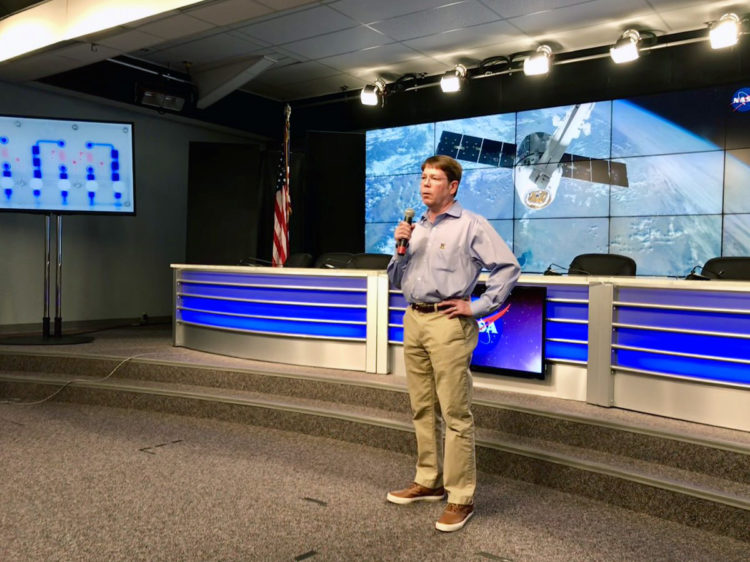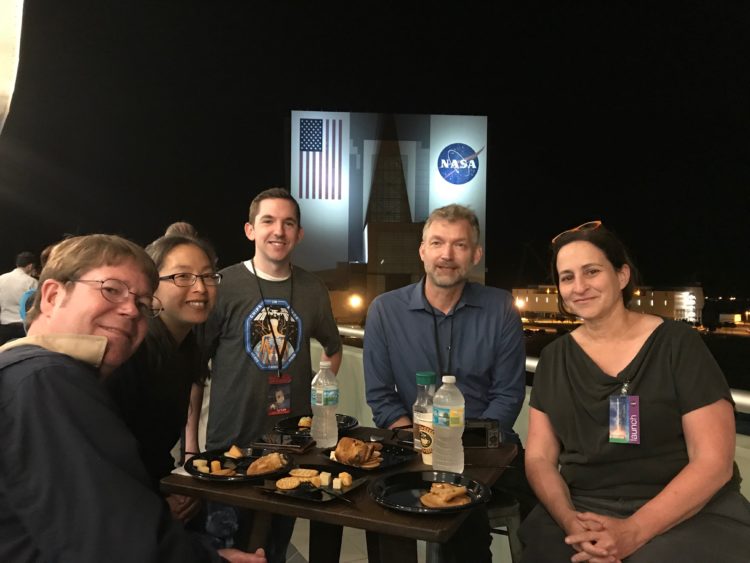
What did it take to send delicate kidney cells into space to be studied by astronauts wearing big, clunky gloves who may, or may not, have a background in biochemistry? We popped into the lab to talk to Ed Kelly and Cathy Yeung to find out.
Dawg Scripts: Why did you put kidney cells on a chip?
Associate Professor Ed Kelly: As a Toxicologist, we talk about the “Three Rs” when it comes to our research: reduce, refine, and replace. That means we are looking for ways to reduce animal testing, refine processes, and—where we can—replace animal testing. With Kidney on a Chip, we have a better model than testing kidney cells on plates under the microscope, in petri dishes, or with animals. The tubules—about the size of a human hair—housing the cells in the chip mirror the tubules in the kidney in the body and, like the kidney in the body, we can move fluid through the tubules and have more information than we would otherwise. For example, we did some testing using a powerful antibiotic. We knew the antibiotic was toxic but we didn’t know why. By using Kidney on a Chip, we were able to identify the biomarkers of toxicity, showing that the antibiotic was indeed toxic to renal tubular cells.
“We are planning for failure, even though that’s not an option.”—Ed Kelly, Associate Professor of Pharmaceutics
DS: So then why send chips to space?
Research Assistant Professor Cathy Yeung, ’05: Kidney disease can take years to develop. Microgravity accelerates kidney disease or dysfunction, and other conditions in astronauts, so the goal is to see the impact low gravity will have on the cells in the microphysiological chips. We anticipate learning more about how kidney stones, osteoporosis, and proteinuria (an abnormally high amount of protein in urine which indicates kidney damage) begins and develops. There aren’t many effective treatments for kidney stones currently. Last year, the main “recommendation” for treatment was to ride a roller coaster in hopes of dislodging the stone (we don’t recommend this course of treatment). Instead, we hope to gain some insights into how they develop that may lead to improved therapies.
DS: What can you tell us about the cell samples you are using?
CY: The kidney cells used come from two men and two women so we will be able to see gender differences, which is important for diseases like osteoporosis which has a higher incidence among women. All of this research is important for people on Earth, as well as the future of missions to Mars when people will be in microgravity for years. We have questions about how kidneys process Vitamin D and hope to gain insight about osteoporosis and how to prevent it from this research.

DS: What are some of the challenges of sending the chips to space?
EK: We’ve had a lot of logistical challenges. First of all, we have to make the level of science very easy for
astronauts who will be working with large gloves. Some of the astronauts have advanced degrees in science, but we had to make sure that whoever is running the experiment that day could do the work needed. Another challenge was taking the 50 cubic feet of space we use to run the experiments in our lab down to a box about the size of a microwave to fit in the rocket and space station, which is why we partnered with BioServe Space Technologies at University of Colorado Boulder.
DS: Will there be a lab in space?

CY: There will be experiments running at precisely the same time on the ground as in the Space Station while the Chips are in space. Our team of faculty and graduate students will be on site at Kennedy Space Center in Florida running the experiments on Earth. So we have to create labs that will go to space and also recreate our lab in Florida. The box going to space with the chips has to be specially designed to handle the stressors of coming in and out of atmosphere, the vibrations in breaking the sound barrier, and dropping to Earth on its return. The kidney cells have to be kept at a constant 37 degree C temperature, which requires three different power sources from the time the chips are built on the lab on Earth, transferred to the rocket, and launched into space. We don’t know what will happen and we are doing our best, working with our BioServe partners, to anticipate as many obstacles as possible.
DS: What’s special about this project?
EK: We are proud that the University of Washington is the only university with two projects launching to the International Space Station as part of this nationwide Organ on a Chip project funded by the NIH and CASIS. Our project will be the first to launch and the Heart on a Chip by Deok-Ho Kim in Bioengineering will be the second.
Below are scenes from the Launch that happened on May 4, 2019. May the Fourth Be With You, was the rally cry of the day after multiple delays.
To watch the launch video, click here for a link to the SpaceX YouTube page.
See NASA’s photos of the Kidney on a Chip experiment in space!


Read more about the Kidney on a Chip project
To study with researchers like Pharmaceutics’ Associate Professor Ed Kelly and Pharmacy’s Research Assistant Professor Cathy Yeung, click on the links for more information about our Graduate Programs in Medicinal Chemistry, Pharmaceutics, Pharmaceutical Outcomes Research and Policy, and Biomedical Regulatory Affairs.